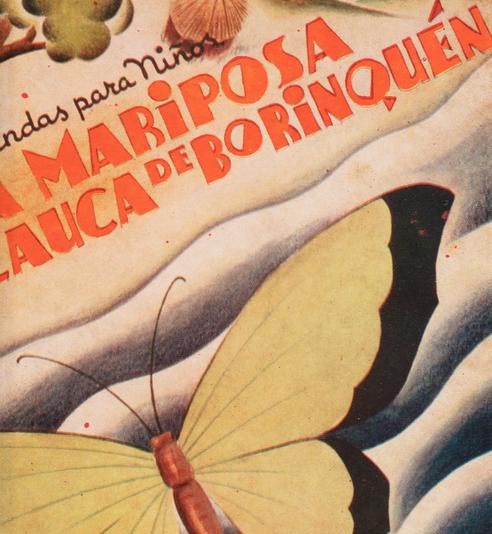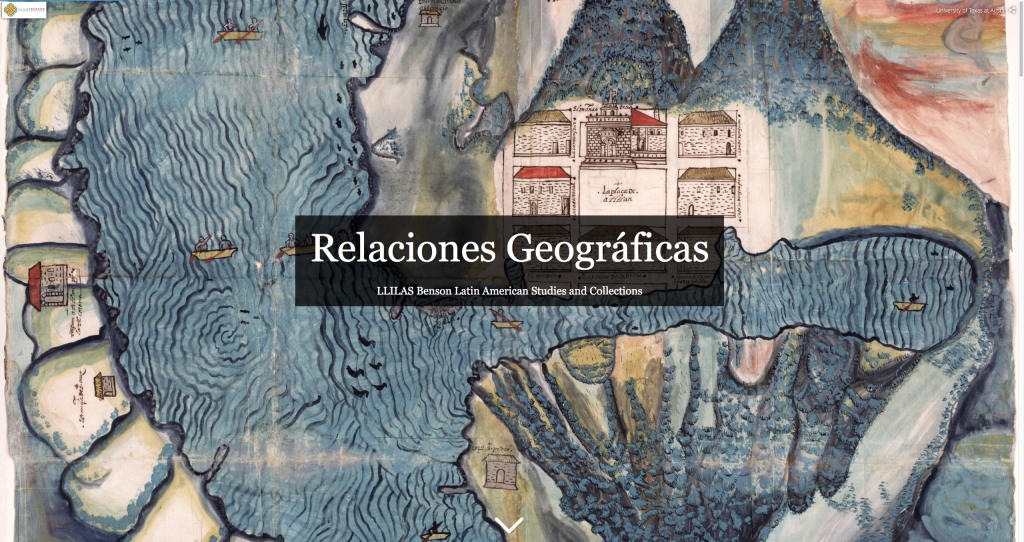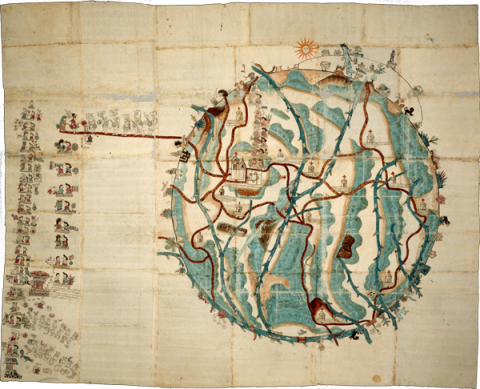
Primary sources are texts, images, audiovisual recordings, or other materials produced during the time period and in the place an essay, research paper, or project analyzes.
Primary sources can include (but are not limited to): newspaper articles written at the time of the event, diaries or journals, letters or other correspondence, transcriptions or recordings of speeches, audiovisual recordings of an event, photographs, artwork, government records, business ledgers or files, or maps. They also include oral history interviews about a person's firsthand experiences. Scholars examine and use primary sources as evidence to support their argument or analysis of a topic.
Biblioteca Hispánica
 The Bibloteca Hispánica at the Biblioteca Digital AECID includes humanities and social science collections focused on Latin America and the Philippines. It includes materials on Spanish colonization in the Americas, Catholic Spanish kings, and conversion to Catholicism in the Americas. The oldest text in the collection is Coronica de las indias: la historia general de las indias, published in Salamanca in 1547. Spanish
The Bibloteca Hispánica at the Biblioteca Digital AECID includes humanities and social science collections focused on Latin America and the Philippines. It includes materials on Spanish colonization in the Americas, Catholic Spanish kings, and conversion to Catholicism in the Americas. The oldest text in the collection is Coronica de las indias: la historia general de las indias, published in Salamanca in 1547. Spanish
Center for Research Libraries
 The Center for Research Libraries collection includes digitized newspapers and magazines from Latin America. It also features an archive of domestic and foreign newspapers on microfilm, which can be borrowed through the library's Interlibrary Loan service. English, includes Spanish and Portuguese materials
The Center for Research Libraries collection includes digitized newspapers and magazines from Latin America. It also features an archive of domestic and foreign newspapers on microfilm, which can be borrowed through the library's Interlibrary Loan service. English, includes Spanish and Portuguese materials
Digital Archive of Latin American and Caribbean Ephemera
 The Digital Archive of Latin American and Caribbean Ephemera is a growing repository containing a previously unavailable subset of Princeton’s Latin American Ephemera Collection as well as newly acquired materials being digitized and added on an ongoing basis. The bulk of the materials currently found in the Digital Archive were originally created around the turn of the 20th century and after. The formats most commonly included are pamphlets, flyers, leaflets, brochures, posters, stickers, and postcards. These items were originally created by a wide array of social activists, non-governmental organizations, government agencies, political parties, public policy think tanks, and other types of organizations in order to publicize their views, positions, agendas, policies, events, and activities. English, Spanish, and Portuguese
The Digital Archive of Latin American and Caribbean Ephemera is a growing repository containing a previously unavailable subset of Princeton’s Latin American Ephemera Collection as well as newly acquired materials being digitized and added on an ongoing basis. The bulk of the materials currently found in the Digital Archive were originally created around the turn of the 20th century and after. The formats most commonly included are pamphlets, flyers, leaflets, brochures, posters, stickers, and postcards. These items were originally created by a wide array of social activists, non-governmental organizations, government agencies, political parties, public policy think tanks, and other types of organizations in order to publicize their views, positions, agendas, policies, events, and activities. English, Spanish, and Portuguese
Digital National Security Archive
 The Digital National Security Archive consists of declassified government documents covering U.S. policy toward critical world events – including their military, intelligence, diplomatic and human rights dimensions – from 1945 to the present. Each collection is assembled by foreign policy experts and features chronologies, glossaries, bibliographies, and scholarly overviews. The website for the National Security Archive includes additional information about the archive's history as well as Freedom of Information Act requests. English
The Digital National Security Archive consists of declassified government documents covering U.S. policy toward critical world events – including their military, intelligence, diplomatic and human rights dimensions – from 1945 to the present. Each collection is assembled by foreign policy experts and features chronologies, glossaries, bibliographies, and scholarly overviews. The website for the National Security Archive includes additional information about the archive's history as well as Freedom of Information Act requests. English
Latin American Digital Initiatives (LADI)
 Latin American Digital Initiatives (LADI) is a collaboration between LLILAS Benson Latin American Studies and Collections at The University of Texas at Austin, the University of Texas Libraries, and Latin American partner institutions to preserve and provide access to unique archival documentation from Latin America, with an emphasis on collections documenting human rights and underrepresented communities. English, Spanish, and Portuguese
Latin American Digital Initiatives (LADI) is a collaboration between LLILAS Benson Latin American Studies and Collections at The University of Texas at Austin, the University of Texas Libraries, and Latin American partner institutions to preserve and provide access to unique archival documentation from Latin America, with an emphasis on collections documenting human rights and underrepresented communities. English, Spanish, and Portuguese
Latin American Newspapers
 Latin American Newspapers, also known as World Newspaper Archive - Latin American Newspapers, provides access to newspapers published in the 19th and 20th centuries from Argentina, Brazil, Bolivia, Belize, Costa Rica, Chile, Cuba, El Salvador, Guatemala, Haiti, Mexico, Nicaragua, Peru, and Venezuela from 1822 to 1922. English, materials in Spanish
Latin American Newspapers, also known as World Newspaper Archive - Latin American Newspapers, provides access to newspapers published in the 19th and 20th centuries from Argentina, Brazil, Bolivia, Belize, Costa Rica, Chile, Cuba, El Salvador, Guatemala, Haiti, Mexico, Nicaragua, Peru, and Venezuela from 1822 to 1922. English, materials in Spanish
Slavery, Abolition, and Social Justice
 The Slavery, Abolition, and Social Justice resource includes primary sources about the history of enslavement in the Atlantic world. It is designed for both teaching and research use, and includes extensive coverage of topics such as the African coast; the Middle Passage; the varieties of enslaved experiences (urban, domestic, industrial, farm, ranch and plantation); spiritualism and religion; resistance and revolts; the Underground Railroad; the abolition movement; legislation; education; the legacy of enslavement and enslavement today. English
The Slavery, Abolition, and Social Justice resource includes primary sources about the history of enslavement in the Atlantic world. It is designed for both teaching and research use, and includes extensive coverage of topics such as the African coast; the Middle Passage; the varieties of enslaved experiences (urban, domestic, industrial, farm, ranch and plantation); spiritualism and religion; resistance and revolts; the Underground Railroad; the abolition movement; legislation; education; the legacy of enslavement and enslavement today. English
Microform Materials
 Microform Collections are located on Level B of the Babbidge Library. These collections consist of microfilm (reels) and microfiche (sheets). They are grouped by format and arranged alphabetically by collection title in the microform cabinets. Microform collections are research materials that cannot be checked out from the library. See Finding Materials on Microform for additional information.
Microform Collections are located on Level B of the Babbidge Library. These collections consist of microfilm (reels) and microfiche (sheets). They are grouped by format and arranged alphabetically by collection title in the microform cabinets. Microform collections are research materials that cannot be checked out from the library. See Finding Materials on Microform for additional information.
UConn Archives and Special Collections
 UConn Library's Archives and Special Collections (ASC) includes several collections of rare books, journals, and government records relevant to Latin America and the Caribbean. The majority of the collections are accessible through an in-person visit to the archive, and several of these collections have been digitized. The tabs above include additional information about several relevant collections. Visit the Archives and Special Collections website for additional information about access and planning your visit.
UConn Library's Archives and Special Collections (ASC) includes several collections of rare books, journals, and government records relevant to Latin America and the Caribbean. The majority of the collections are accessible through an in-person visit to the archive, and several of these collections have been digitized. The tabs above include additional information about several relevant collections. Visit the Archives and Special Collections website for additional information about access and planning your visit.
 The Latin American Newspapers collection includes approximately 2000 titles of the Latin American and Caribbean newspapers. The collection is strongest for the late nineteenth century and contains newspapers from virtually every country of Latin America and the Caribbean. The most notable portion of the collection is represented by newspapers from Bolivia. Twenty-nine cities of Bolivia are represented with major holdings from the cities of La Paz and Cochabamba. Two of these newspapers have been digitized.
The Latin American Newspapers collection includes approximately 2000 titles of the Latin American and Caribbean newspapers. The collection is strongest for the late nineteenth century and contains newspapers from virtually every country of Latin America and the Caribbean. The most notable portion of the collection is represented by newspapers from Bolivia. Twenty-nine cities of Bolivia are represented with major holdings from the cities of La Paz and Cochabamba. Two of these newspapers have been digitized.
José Toribio Medina was a Chilean bibliographer, writer, and historian. The materials in the Medina Collection include books that were written by him as well as books about his work on the printing history of many Latin American countries including Chile.
The Mexican Broadsides and Pamphlet Collection includes approximately 300 Mexican broadsides consisting mainly of governmental decrees, proclamations, and circulars from the first half of the nineteenth century. This collection features documents on such subjects as the economy, farming, elections, and military and ecclesiastical communications. Also included is a manuscript hacienda account book of the Marquesa de Apartado from 1850.
 The North American Congress on Latin America (NACLA) Archive of Latin Americana brings together publications from and about Latin America. In response to the April 1965 U.S. invasion of the Dominican Republic, NACLA was founded in October and November of 1966 in a series of meetings of Students for a Democratic Society (SDS), the Student Nonviolent Coordinating Committee, the University Christian Movement, and returned Peace Corps volunteers, along with assorted other individuals and organizations. The ASC collection includes primary sources as well as research institutes' working papers and other similar types of scholarship. A large portion of the archive was microfilmed in 1998.
The North American Congress on Latin America (NACLA) Archive of Latin Americana brings together publications from and about Latin America. In response to the April 1965 U.S. invasion of the Dominican Republic, NACLA was founded in October and November of 1966 in a series of meetings of Students for a Democratic Society (SDS), the Student Nonviolent Coordinating Committee, the University Christian Movement, and returned Peace Corps volunteers, along with assorted other individuals and organizations. The ASC collection includes primary sources as well as research institutes' working papers and other similar types of scholarship. A large portion of the archive was microfilmed in 1998.
Published NACLA Reports are available at Archives and Special Collections (1967-1971 and 1971-1977) and at the Homer Babbidge Library (1977-1991 and 1991-1993).
 The Puerto Rican Collection, formerly known as the Géigel Family Collection or Géigel Collection was created and maintained by the Géigel Family over three generations. The collection was started by José (Pepe) Géigel Zenón, who was a reporter and well known Puerto Rican intellectual, a relative of the writer Manuel Zenón Gandía, and a personal friend of the writer Alejandro Tapia y Rivera. His son Fernando Géigel and granddaughter Luisa Géigel continued to build the collection.
The Puerto Rican Collection, formerly known as the Géigel Family Collection or Géigel Collection was created and maintained by the Géigel Family over three generations. The collection was started by José (Pepe) Géigel Zenón, who was a reporter and well known Puerto Rican intellectual, a relative of the writer Manuel Zenón Gandía, and a personal friend of the writer Alejandro Tapia y Rivera. His son Fernando Géigel and granddaughter Luisa Géigel continued to build the collection.
UConn ac quired the Puerto Rican collection in the 1980s from Luisa Géigel with the help of historian Francisco Scarano who worked at the university at the time. Selections of the collection have been digitized, including Luisa Gégel's handwritten index of the books.
quired the Puerto Rican collection in the 1980s from Luisa Géigel with the help of historian Francisco Scarano who worked at the university at the time. Selections of the collection have been digitized, including Luisa Gégel's handwritten index of the books.
Additional information the collection is available on the bilingual Colección Digital Puertorriqueña/Digital Puerto Rican Collection guide.
José Geigel Zeón and Fernando Géigel Sabat, Géigel y Zenón, J., Morales Ferrer, A., and Géigel Sabat, F. Bibliografía puertorriqueña. Barcelona: Editorial Araluce, 1934.
 The Puerto Rico Civil Court Documents collection includes more than 10,000 pages of records produced by the Arecibo appellate court district between 1844 and 1900. It includes court cases from the towns of towns of Arecibo, Barceloneta, Camuy, Ciales, Hatillo, Manati, Morovis, Quebradillas, and Utuado.
The Puerto Rico Civil Court Documents collection includes more than 10,000 pages of records produced by the Arecibo appellate court district between 1844 and 1900. It includes court cases from the towns of towns of Arecibo, Barceloneta, Camuy, Ciales, Hatillo, Manati, Morovis, Quebradillas, and Utuado.
The Thomas J. Dodd Research Center acquired the collection in 2000. In 2012, a Latin American Materials Project (LAMP) grant funded digitization of the fragile documents, and the complete collection is viewable online.
Regional Primary Source Collections
 Some regional collections focus on topics that span multiple countries. The tabs above include additional information about resources focused on the Caribbean and Mesoamerica.
Some regional collections focus on topics that span multiple countries. The tabs above include additional information about resources focused on the Caribbean and Mesoamerica.
Digital Library of the Caribbean
 The Digital Library of the Caribbean (dLOC) comprises collections that speak to the similarities and differences in histories, cultures, languages and governmental systems. Types of collections include but are not limited to: newspapers, archives of Caribbean leaders and governments, official documents, documentation and numeric data for ecosystems, scientific scholarship, historic and contemporary maps, oral and popular histories, travel accounts, literature and poetry, musical expressions, and artifacts. English, Spanish, and French
The Digital Library of the Caribbean (dLOC) comprises collections that speak to the similarities and differences in histories, cultures, languages and governmental systems. Types of collections include but are not limited to: newspapers, archives of Caribbean leaders and governments, official documents, documentation and numeric data for ecosystems, scientific scholarship, historic and contemporary maps, oral and popular histories, travel accounts, literature and poetry, musical expressions, and artifacts. English, Spanish, and French
Catalog of Digital Historical Newspapers (NewspaperCat)
 The Catalog of Digital Historical Newspapers (NewspaperCat) is a tool that facilitates the discovery of online digitized historical newspaper content from newspapers published in the United States and the Caribbean. NewspaperCat was funded by a grant from the George A. Smathers Libraries at the University of Florida. English with Spanish and French materials
The Catalog of Digital Historical Newspapers (NewspaperCat) is a tool that facilitates the discovery of online digitized historical newspaper content from newspapers published in the United States and the Caribbean. NewspaperCat was funded by a grant from the George A. Smathers Libraries at the University of Florida. English with Spanish and French materials
Early Caribbean Digital Archive (ECDA)
 The Early Caribbean Digital Archive (ECDA) is an open access collection of pre-twentieth-century Caribbean texts, maps, and images. Texts include travel narratives, novels, poetry, natural histories, and diaries. Supported by Northeastern University, the archive archive currently holds 57 early Caribbean texts, including novels, travel narratives, natural histories, colonial documentation, obeah narratives, and narratives of enslaved persons. Thirty of these are prefaced with scholarly introductions. English
The Early Caribbean Digital Archive (ECDA) is an open access collection of pre-twentieth-century Caribbean texts, maps, and images. Texts include travel narratives, novels, poetry, natural histories, and diaries. Supported by Northeastern University, the archive archive currently holds 57 early Caribbean texts, including novels, travel narratives, natural histories, colonial documentation, obeah narratives, and narratives of enslaved persons. Thirty of these are prefaced with scholarly introductions. English
Mesoamerican Codices
 Codices produced in Mesoamerica before and after the Spanish invasion in 1519 offer a rich source for understanding the history of the region that includes the area spanning from central Mexico, through Belize, El Salvador, Honduras, Nicaragua, to northern Costa Rica.
Codices produced in Mesoamerica before and after the Spanish invasion in 1519 offer a rich source for understanding the history of the region that includes the area spanning from central Mexico, through Belize, El Salvador, Honduras, Nicaragua, to northern Costa Rica.
Many codices were destroyed by the Spanish colonizers in the sixteenth century. However, surviving codices are digitized and available online. UConn Library's Archives and Special Collections includes high quality facsimiles of some of these codices that are available for consultation, including the Codex Mendoza pictured here.
 The World Digital Library of the Library of Congress features Mesoamerican Codices including the Codex Colombino (c. 1100), Dresden Codex (c.1200), Aubin Tonalamatl (1400), Sigüenza Map (1500), Matrícula de tributos (Tribute Roll, 1522), Codex Azcatitlan (1530), Huexotzinco Codex (1531), Codex Vergara (1539), Florentine Codex (1577), Codex Totomixtlahuaca (1584), and Codex of Huamantla (1592).
The World Digital Library of the Library of Congress features Mesoamerican Codices including the Codex Colombino (c. 1100), Dresden Codex (c.1200), Aubin Tonalamatl (1400), Sigüenza Map (1500), Matrícula de tributos (Tribute Roll, 1522), Codex Azcatitlan (1530), Huexotzinco Codex (1531), Codex Vergara (1539), Florentine Codex (1577), Codex Totomixtlahuaca (1584), and Codex of Huamantla (1592).
Mesoamerican Maps
 The Benson Latin American Collection has digitized Joaquín García Icazbalceta's Collection of Relaciones Geográficas of Mexico and Guatemala. The manuscripts were prepared by local Spanish officials in New Spain in response to King Philip II's 1577 questionnaire, and the artistic renderings of the geography that accompanied the written text often were prepared by Indigenous map-makers. Benson's collection features 43 of the original 191 responses, including 26 with accompanying artistic renderings.
The Benson Latin American Collection has digitized Joaquín García Icazbalceta's Collection of Relaciones Geográficas of Mexico and Guatemala. The manuscripts were prepared by local Spanish officials in New Spain in response to King Philip II's 1577 questionnaire, and the artistic renderings of the geography that accompanied the written text often were prepared by Indigenous map-makers. Benson's collection features 43 of the original 191 responses, including 26 with accompanying artistic renderings.
 The Mapas Project breaks down manuscripts from from the pre-Colombian period through the eighteenth century into their pictorial and textual elements for close, collaborative study. Supported by the Wired Humanities Project (WHP) at the University of Oregon, the project includes digitized Nahua, Mixtec, Zapotec, and Spanish maps.
The Mapas Project breaks down manuscripts from from the pre-Colombian period through the eighteenth century into their pictorial and textual elements for close, collaborative study. Supported by the Wired Humanities Project (WHP) at the University of Oregon, the project includes digitized Nahua, Mixtec, Zapotec, and Spanish maps.
Featured Collection: Latin American Reader Series
The Latin American Reader series includes selections of primary sources from the colonial period to the present. The sources, translated into English, include songs, paintings, photographs, poems, short stories, speeches, cartoons, government reports and proclamations, and pieces by historians, journalists, and others. Each section and individual selection is preceded by a brief introduction by the editors. English
Country-Specific Primary Sources

Mexico
Includes sources about Mexico-U.S. borderlands.

United States
Includes sources about US-Mexico borderlands. Includes Latina/o/x sources. See also specific page for Puerto Rican primary sources.





















